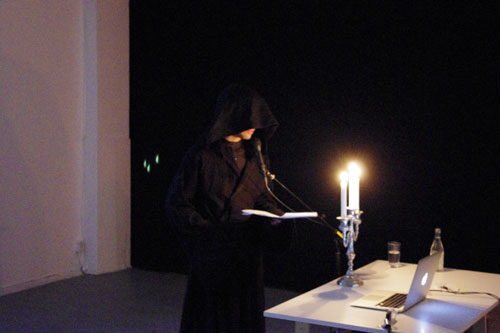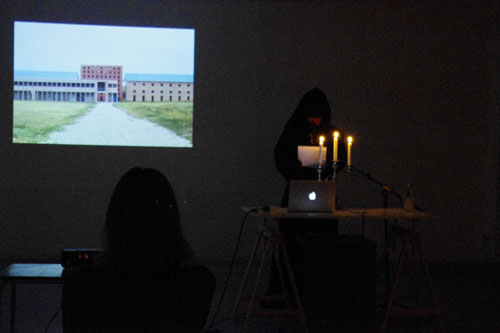As I mentioned in an earlier blog post, I grew up during the 1980s, the era of videogames and heavy metal. I started to listen to German Thrash and Speed metal and eventually ended up a fan of Death and Black Metal. If the combination of videogames and art is a small yet growing part of the contemporary art scene, Black Metal represents an even smaller part of it. But things are changing. It has been a while since Black Metal was a subversive Norwegian subculture. Today, Black Metal has become both mainstream and commercial. During 2011, Sweden saw an increasing interest for darkness and Black Metal within its contemporay art scene. Two Swedish exhibitions–Nordic Darkness and Om ljuset tar oss–focused on Black metal (it may not sound like much, but remember Sweden is a small country, and compared to previous years, that’s a lot of exhibitions). During the summer of 2011, I wrote a series of articles about Black Metal in contemporay art and realized that the subject was much broader than I had thought. For example, I came across the artist and theorist Amelia Ishmael (a previous Art21 guest blogger) and realized that Black Metal theory is now even taught in the programs of several different Universities.
After I had finished writing this series of articles, I came across an interesting performance held at Skånes Konstförening in Malmö, Sweden. I’d like to share an interview I did with the artists, in order to illustrate one of the ways that artists are using Black Metal in contemporary art today.*
[A short digression in order to explain the Swedish word konstförening: In German you would say kunstverein, and the closest English equivalent would be “art club.” A konstförening is a member-owned, non-profit association in which all types of people who share a common intrest in art can be members–not just artists. The main focus for art clubs is on presenting exhibitions, educating members and visitors, presenting lectures and an art lottery. In Sweden, konstföreningar has exististed since the late 1800s, and today there are around 900 art clubs, approxiamly 350 of them public and the rest affiliated with companies, goverments and instutions which are only open to the staff at that workplace. Skåne Konstförening is one of the public art clubs (it was started in 1904), but it remains a vital art club focused on both Swedish and international contemporary art.]
One of the events at Skånes Konstförening was a Black Metal performance held on a dark evening at the beginning of October 2011. Yuki Higashino, a Vienna-based artist, created a performance that mixed Postmodern architecture, Nordic Black Metal and holy minimalism [a term that refers to the work of a number of late-twentieth-century composers whose compositions are distinguished by a minimalist aesthetic and religious or mystical themes]. When we spoke, Yuki Higashino elaborated on the occurences onstage that night:
“It was an architect’s PowerPoint presentation as a black metal concert. I made an architectural proposal to turn San Cataldo cemetery in Modena, Italy (designed by Aldo Rossi) into a recreational space for postmodern architects, black metal musicians and holy minimalist composers. The slideshow was accompanied by a sound collage of instrumental parts of canonical black metal songs and holy minimalist compositions. I read a text written by Aldo Rossi on the cemetery (published in Oppositions) as though it were a black metal song.”
After the performance, Yuki Higashino and Anna Norberg, a Swedish freelance curator, released an exclusive artist’s book titled “Oppositions 666.” Oppositions was an architectural journal published at The Institute for Architecture & Urban Studies in New York from 1973 to 1984. The journal was edited by Peter Eisenman and other well-known architects. In “Oppositions 666,” you can find a a selection of back issues of Oppositions, re-mixed with notes from Anna’s diaries, drawings and Metal symbolics. I talked with Yuki and Anna about this and other projects; the following is an excerpt from our conversations.
Yuki: As Oppositions was edited by Peter Eisenman, its support for postmodern positions was conspicuous. I decided to focus on Italian postmodernism, as the transformation of ideology from its original progressive position to today’s populism, exemplified by Northern League (whose emergence more or less coincided with that of black metal in Norway), illustrates the inherent ambivalence and danger of historicist rhetoric very well. By linking Oppositions to today’s right-wing populism, I was also nodding to Eisenman’s efforts to rehabilitate problematic figures from architectural history such as Giuseppe Terragni.
Anna: About my part in the artist book: I chose to write a seven-day diary because it allowed me to experiment with the form, and also, I wanted to blend my own personal experiences with the research material and art historical analysis and facts. During parts of my research I was visiting a small town in Turkey. The mix between the Black Metal material I saw, listened to and read, together with my personal adventures, provided a lot of ideas for my writing.
Mathias Jansson: So how did your collaboration start?
Anna: Yuki and I started to collaborate maybe one year ago. We met when Yuki did a year at the Art Academy in Copenhagen. At the time, I was working with a residency program for freelance curators in Malmö: Far Away So Close. So we met through one of the curators-in-residence.
Yuki: The conversation about Anna inviting me to do a performance in Malmö started around a year and a half ago. The book idea came about early this year, when I found out that there was budget money available from Skånes Konstförening.
MJ: Are you both Black Metal fans? What is your relationship to this genre?
Anna: I’m not a Black Metal fan. I find some of the music interesting, the way it captures and creates certain moods or state of minds. But it’s not the kind of music I would listen to without a certain purpose. My relationship with Black Metal is based on my interest in its visual language. The subculture of Black Metal seem to lack, at least in my opinion, self distance or maybe even irony – not that I have any idea of how that would be expressed, but Black Metal seem to be devoted to preserving something pure and real even though it has reached some mainstream levels, in music and visuals. What I find fascinating is its total seriousness. And as an art historian I find some interesting discussions and questions in the visual culture of Black Metal.
Yuki: My interest in Black Metal is almost purely sociological and historical. It is true that I do like some of the records musically, particularly those by Burzum, but that was not the impetus for this piece. I have no personal involvement with the metal scene beyond my iTunes collection, and in fact, that detachment was a part of the theme of my piece.
MJ: What was it about Black Metal music and culture that fascinated you to the extent that you decided to use it in your art?
Anna: The strange mixture of references; the use of images from 19th century national romanticism, bourgeois objects and nature photography, the expression of evil, death, Satanism and Asatru – all presented in quite minimalistic fashion in black and white, with a touch of “do it yourself” and bad taste. A visual language that’s easy to recognize, but difficult to relate to. The active choice of imagery, a profile, is also a method of creating an image for promotion and marketing purposes. But what I find interesting is that, at least in early Norwegian Black Metal, there were no such thing as an image, it was all about being authentic and true–to be Black Metal as a life style, that is. And also the almost total lack of female participation. I don’t know, but it seems like women are not very much accepted or appreciated within the scene. But of course when it comes to fans or active listeners I have no idea about how big or small the numbers are that represent women. Women are most certainly as well drawn to explore “evil” and to play and listen to aggressive music. And some women have extreme political views. But just like many other cases, females are given less attention and within Black Metal its really evident. There are quite conservative tendencies within Black Metal towards women, and also the existence of outspoken homophobia.
Yuki: I am interested in cultural situations where simulated products identified by historical postmodernism are normalised and integrated into contemporary society. Heavy Metal is an exemplary postmodern genre where everything is simulated and performed; both musicians and audience embrace its theatricality. Their allegiance to Satanism is a particularly telling expression of this performance, as the knowledge of Satanism’s obvious lack of reality and utter irrelevance is suspended, in order to enhance the pleasure of consumption. It’s a total departure from the Modernist pursuit of authenticity. The drive behind postmodernism is to produce performances that are ever-more convincing, despite the fact that everyone knows they are performances. In that regard, Black Metal can be viewed as the ultimate postmodern product: a fake so convincing that even its producers took it for real.
MJ: So what do Postmodern architecture, Nordic Black Metal, and holy minimalism have in common?
Yuki: As an artist, it is more important for me to comprehend representation rather than locate truth, so research on Black Metal was by default research on rightwing populism. And this politics is central to my work as what it really tried to address is the ambivalent politics of Italian postmodern architecture, Nordic black metal, and East European holy minimalism. In all three cultural phenomena, distinctions between opposition to a dominant political order and conformity to reactionary oppression are totally blurred, and contradictory positions are constantly exchanged. And in all three of them, historicism is employed as a tool to justify this ideological confusion. It is interesting to note that, despite their seeming differences, these three groups’ views on European history and culture are fairly compatible.
*****
*For more on Black Metal in contemporary art, see Amelia Ishmael’s series of guest blog posts here.







Pingback: The Unholy Trinity of Postmodern Architects, Black Metal, and Holy Minimalism | Benjamin Phillips